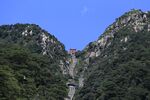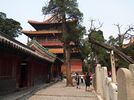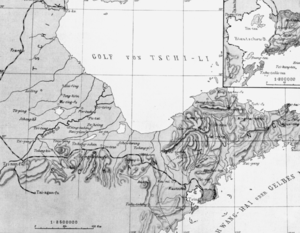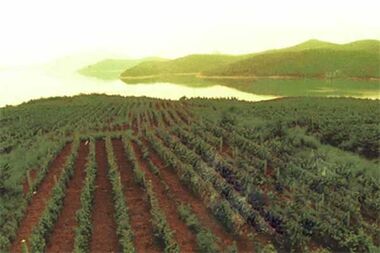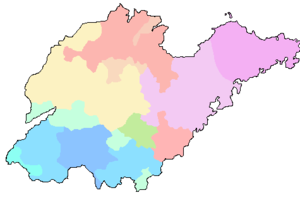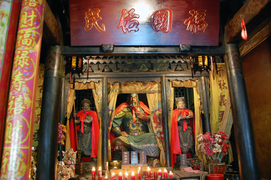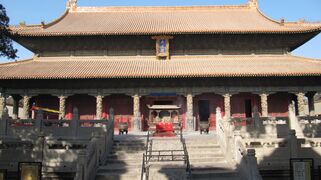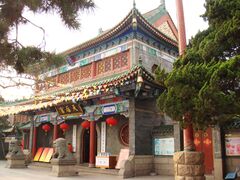شاندونغ
شعب شان دونگ، انظر شعب شان دونگ
Shandong Province
山东省 | |
|---|---|
| الترجمة اللفظية بالـ Name | |
| • Chinese | 山东省 (Shāndōng Shěng) |
| • Abbreviation | SD / 鲁 (پنين: Lǔ�) |
From top to bottom, left to right: Thousand Buddha Mountain in Jinan, aerial view of Qingdao, views of the South Gate to Heaven at Mount Tai, Temple of Confucius in Qufu | |
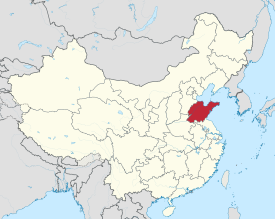 Map showing the location of Shandong Province | |
| الإحداثيات: 36°24′N 118°24′E / 36.4°N 118.4°ECoordinates: 36°24′N 118°24′E / 36.4°N 118.4°E | |
| العاصمة | جينان |
| Largest city | Linyi (population & area)
جينان (urban population & urban area & downtown population) Qingdao (downtown area) |
| Divisions | 16 prefectures، 140 counties، 1941 townships |
| الحكومة | |
| • Secretary | Liu Jiayi |
| • Governor | Li Ganjie |
| المساحة | |
| • الإجمالي | 157٬100 كم² (60٬700 ميل²) |
| ترتيب المساحة | 20th |
| أعلى منسوب (جبل تاي) | 1٬545 m (5٬069 ft) |
| التعداد (2018)[2] | |
| • الإجمالي | 100٬472٬400 |
| • الترتيب | 2nd |
| • الكثافة | 640/km2 (1٬700/sq mi) |
| • ترتيب الكثافة | 5th |
| Demographics | |
| • Ethnic composition | Han - 99.3% Hui - 0.6% |
| • Languages and dialects | Jiaoliao Mandarin, Jilu Mandarin, Zhongyuan Mandarin |
| ISO 3166 code | CN-SD |
| GDP (2018) | CNY 7.65 trillion USD 1.156 trillion $2.0 trillion (PPP)[3] (3rd) |
| • per capita | CNY 76,908 USD 11,617 (9th) |
| HDI (2018) | ▲ 0.765[4] high · 10th |
| الموقع الإلكتروني | SD.gov.cn |
| شاندونغ | |||||||||||||||||||||||||||||||||
|---|---|---|---|---|---|---|---|---|---|---|---|---|---|---|---|---|---|---|---|---|---|---|---|---|---|---|---|---|---|---|---|---|---|
 "Shandong" in Simplified (top) and Traditional (bottom) Chinese characters | |||||||||||||||||||||||||||||||||
| الصينية المبسطة | 山东 | ||||||||||||||||||||||||||||||||
| الصينية التقليدية | 山東 | ||||||||||||||||||||||||||||||||
| المعنى الحرفي | "East of the Mountains (Taihang)" | ||||||||||||||||||||||||||||||||
| |||||||||||||||||||||||||||||||||
شاندونگ، Shandong (الصينية المبسطة: 山东؛ الصينية التقليدية: 山東؛ پنين: Shāndōng؛ ويد–جايلز: Shan-tung�)، هي مقاطعة داخلية في الصين. تقع على واجهة خليج بوهاي والبحر الأصفر (بحر الصين)، تقابلها على الواجهة الأخرى شبه جزيرة "لياودونگ". عاصمتها مدينة "جينان".
Shandong has played a major role in Chinese history since the beginning of Chinese civilization along the lower reaches of the Yellow River. It has served as a pivotal cultural and religious center for Taoism, Chinese Buddhism and Confucianism. Shandong's Mount Tai is the most revered mountain of Taoism and one of the world's sites with the longest history of continuous religious worship.[5] The Buddhist temples in the mountains to the south of the provincial capital of Jinan were once among the foremost Buddhist sites in China.[6] The city of Qufu is the birthplace of Confucius and was later established as the center of Confucianism. Confucianism developed from what was later called the Hundred Schools of Thought from the teachings of the Chinese philosopher Confucius.[7]
Shandong's location at the intersection of ancient as well as modern north–south and east–west trading routes have helped to establish it as an economic center. After a period of political instability and economic hardship that began in the late 19th century, Shandong has experienced rapid growth in recent decades. Home to over 100 million inhabitants, Shandong is the world's sixth-most populous subnational entity, and China's second most populous.[2] The economy of Shandong is China's third largest provincial economy with a GDP of CNY¥7.65 trillion in 2018 or USD$1.156 trillion; its GDP per capita is around the national average.[8]
. . . . . . . . . . . . . . . . . . . . . . . . . . . . . . . . . . . . . . . . . . . . . . . . . . . . . . . . . . . . . . . . . . . . . . . . . . . . . . . . . . . . . . . . . . . . . . . . . . . . . . . . . . . . . . . . . . . . . . . . . . . . . . . . . . . . . . . . . . . . . . . . . . . . . . . . . . . . . . . . . . . . . . . .
الاسم
Individually, the two Chinese characters in the name "Shandong" mean "mountain" (山) and "east" (东). Shandong could hence be translated literally as "east of the mountains" and refers to the province's location to the east of the Taihang Mountains.[9] A common nickname for Shandong is Qílǔ (الصينية المبسطة: 齐鲁؛ الصينية التقليدية: 齊魯�), after the States of Qi and Lu that existed in the area during the Spring and Autumn period. Whereas the State of Qi was a major power of its era, the State of Lu played only a minor role in the politics of its time. Lu, however, became renowned for being the home of Confucius and hence its cultural influence came to eclipse that of the State of Qi. The cultural dominance of the State of Lu heritage is reflected in the official abbreviation for Shandong which is "鲁" (صينية: 魯؛ پنين: Lǔ�). English speakers in the 19th century called the province Shan-tung.[10]
الموقع
The province is on the eastern edge of the North China Plain and in the lower reaches of the Yellow River (Huang He), and extends out to sea as the Shandong Peninsula. Shandong borders the Bohai Sea to the north, Hebei to the northwest, Henan to the west, Jiangsu to the south, and the Yellow Sea to the southeast; it also shares a very short border with Anhui, between Henan and Jiangsu.
التاريخ
التاريخ القديم
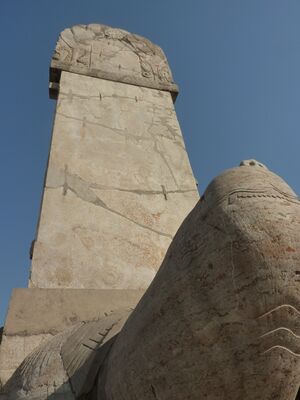
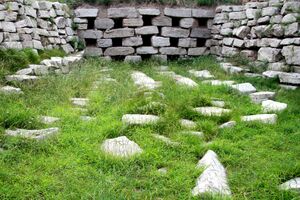
With its location on the eastern edge of the North China Plain, Shandong was home to a succession of Neolithic cultures for millennia, including the Houli culture (6500–5500 BCE), the Beixin culture (5300–4100 BCE), the Dawenkou culture (4100–2600 BCE), the Longshan culture (3000–2000 BCE), and the Yueshi culture (1900–1500 BCE).
ضمت منطقة شاندونگ إلى الصين أثناء حكم "أسرة شانگ" (1765-1066 ق.م) أولى السلالات التي حكمت البلاد. تعتبر مسقط رأس الفلاسفة أمثال: "كونفوشيوس" و"مينگ تسي". كان لها دور كبير في تاريخ الصين القديم.
The earliest dynasties (the Shang dynasty and Zhou dynasty) exerted varying degrees of control over western Shandong, while eastern Shandong was inhabited by the Dongyi peoples who were considered "barbarians." Over subsequent centuries, the Dongyi were eventually sinicized.
During the Spring and Autumn period and the Warring States period, regional states became increasingly powerful. At this time, Shandong was home to two major states: the state of Qi at Linzi and the state of Lu at Qufu. Lu is noted for being the home of Confucius. The state was, however, comparatively small, and eventually succumbed to the larger state of Chu from the south. The state of Qi, on the other hand, was a major power throughout the period. Cities it ruled included Linzi, Jimo (north of modern Qingdao) and Ju.
The easternmost part of the peninsula was ruled by the Dongyi state of Lai until it was conquered by Qi in 567 BC.
التاريخ الامبراطوري المبكر
The Qin dynasty conquered Qi and founded the first centralized Chinese state in 221 BCE. The Han dynasty that followed created a number of commanderies supervised by two regions (刺史部) in what is now modern Shandong: Qingzhou (青州) in the north and Yanzhou (兗州) in the south. During the division of the Three Kingdoms, Shandong belonged to the Cao Wei, which ruled over northern China.
After the Three Kingdoms period, a brief period of unity under the Western Jin dynasty gave way to invasions by nomadic peoples from the north. Northern China, including Shandong, was overrun. Over the next century or so Shandong changed hands several times, falling to the Later Zhao, then Former Yan, then Former Qin, then Later Yan, then Southern Yan, then the Liu Song dynasty, and finally the Northern Wei dynasty, the first of the Northern dynasties during the Northern and Southern dynasties Period. Shandong stayed with the Northern dynasties for the rest of this period.
In 412 CE, the Chinese Buddhist monk Faxian landed at Laoshan, on the southern edge of the Shandong peninsula, and proceeded to Qingzhou to edit and translate the scriptures he had brought back from India.
The Sui dynasty reestablished unity in 589, and the Tang dynasty (618-907) presided over the next golden age of China. For the earlier part of this period Shandong was ruled as part of Henan Circuit, one of the circuits (a political division). Later on China splintered into warlord factions, resulting in the Five Dynasties and Ten Kingdoms period. Shandong was part of the Five Dynasties, all based in the north.
The Song dynasty reunified China in the late tenth century. The classic novel Water Margin was based on folk tales of outlaw bands active in Shandong during the Song dynasty. In 1996, the discovery of over two hundred buried Buddhist statues at Qingzhou was hailed as a major archaeological find. The statues included early examples of painted figures, and are thought to have been buried due to Emperor Huizong's repression of Buddhism (he favored Taoism).
The Song dynasty was forced to cede northern China to the Jurchen Jin dynasty in 1142. Shandong was administered by the Jin as Shandong East Circuit and Shandong West Circuit – the first use of its current name.
التاريخ المعاصر المبكر
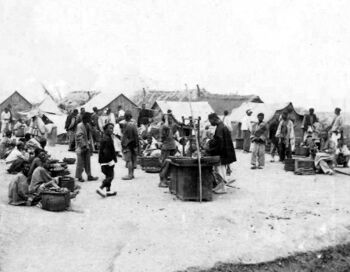
The modern province of Shandong was created by the Ming dynasty, where it had a more expansive territory including the agricultural part of Liaoning. After the Ming–Qing Transition in 1644, Shandong acquired (more or less) its current borders.
During the nineteenth century, China became increasingly exposed to Western influence, and Shandong, a coastal province, was especially affected. چینگداو was leased to Germany in 1897 and Weihai to Britain in 1898. As a result of foreign pressure from the الامبراطورية الروسية, which had annexed Outer Manchuria by 1860, the Qing dynasty encouraged settlement of Shandong people to what remained of northeast China.
Shandong was one of the first places in which the Boxer Rebellion started and became one of the centers of the uprising. In 1899, the Qing general Yuan Shikai was appointed as governor of the province to suppress the uprising. He held the post for three years.
سيطرت ألمانيا على شبه جزيرة شاندونگ. In 1898, Germany had leased Jiaozhou Bay and its port of Qingdao under threat of force. Development was a high government priority. Over 200 million marks were invested in world-class harbor facilities (such as berths, heavy machinery, rail yards, and a floating dry dock. Private enterprise worked across the Shandong Province, opening mines, banks, factories and rail lines.[11]
As a consequence of the First World War, Japan seized Germany holdings in Qingdao and Shandong. The Treaty of Versailles transferred ownership to Japan instead of restoring Chinese sovereignty over the area. Popular dissatisfaction with this outcome, referred to as the Shandong Problem, led to the vehement student protests in the May Fourth Movement. Among the reservations to the Treaty that the United States Senate Committee on Foreign Relations approved was "to give Shantung to China," the treaty with reservations was not approved. Finally, Shandong reverted to Chinese control in 1922 after mediation by the United States during the Washington Naval Conference. Weihai followed in 1930.[12]
The return of control over Shandong fell into the Warlord Era of the Republic of China. Shandong was handed over to the Zhili clique of warlords, but after the Second Zhili–Fengtian War of 1924, the northeast China-based Fengtian clique took over. In April 1925, the Fengtian clique installed the warlord Zhang Zongchang, nicknamed the "Dogmeat General," as military governor of Shandong Province. Time dubbed him China's "basest warlord."[13] He ruled over the province until 1928, when he was ousted in the wake of the التجريدة الشمالية. He was succeeded by Han Fuju, who was loyal to the warlord Feng Yuxiang but later switched his allegiance to the Nanjing government headed by Chiang Kai-shek. Han Fuju also ousted the warlord Liu Zhennian, nicknamed the "King of Shandong East," who ruled eastern Shandong Province, hence unifying the province under his rule.
In 1937 Japan began its invasion of China proper in the Second Sino-Japanese War, which would eventually become part of the Pacific theatre of the Second World War. Han Fuju was made Deputy Commander in Chief of the 5th War Area and put in charge defending the lower Yellow River valley. However, he abandoned his base in Jinan when Japanese troops crossed the Yellow River. He was executed for not following orders shortly thereafter.
Shandong was occupied by Japan, with resistance continuing in the countryside, and was one of the provinces where a scorched earth policy ("Three Alls Policy": "kill all," "burn all," "loot all") was implemented by Japanese general Yasuji Okamura. This lasted until the surrender of Japan in 1945 killing millions of people in Shandong and Northern China.
By 1945, communist forces already held some parts of Shandong. Over the next four years of the Chinese Civil War, they expanded their holdings, eventually driving the Kuomintang (government of the Republic of China) out of Shandong by June 1949. The People's Republic of China was founded in October of the same year.
Under the new government, parts of western Shandong were initially given to the short-lived Pingyuan Province, but this did not last. Shandong also acquired the Xuzhou and Lianyungang areas from Jiangsu province, but this did not last either. For the most part Shandong has kept the same borders that it has today.
About six million people starved to death in Shandong during Great Chinese Famine.[14]
In recent years Shandong, especially eastern Shandong, has enjoyed significant economic development, becoming one of the richest provinces of the People's Republic of China.
بسبب معادنها الوفيرة أقدمت القوى الغربية على بسط سيطرتها على كافة الموانىء فيها وكذا خطوط السكك الحديدة وهذا منذ القرن الـ19 م. تنازلت الصين لبريطانيا عن منطقة "وِيْهاي" (1898-1930) بموجب عقد إيجار. كما حصلت ألمانيا على نفس الحقوق في منطقة چينگداو (1898-1915) لتخلفها اليابان وعلى نفس المنطقة (1915-1922). بدأ الألمان أول أعمال استخراج الفحم في المنطقة، ثم تسارعت الوتيرة أثناء فترة الاحتلال الياباني للصين (1937-1945). عادت "شاندونگ" إلى الصين عام 1945، بعد انتهاء الحرب العالمية الثانية.
. . . . . . . . . . . . . . . . . . . . . . . . . . . . . . . . . . . . . . . . . . . . . . . . . . . . . . . . . . . . . . . . . . . . . . . . . . . . . . . . . . . . . . . . . . . . . . . . . . . . . . . . . . . . . . . . . . . . . . . . . . . . . . . . . . . . . . . . . . . . . . . . . . . . . . . . . . . . . . . . . . . . . . . .
الجغرافيا
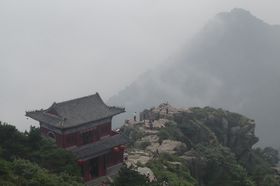
يغلب على تضاريسها الطبيعة الصخرية والجبلية، شواطئها متقطعة. في الشمال يقسم المنخفض المركزي المطل على شرم (خليج) "كياو تشو" جزئها شبه جزية "شاندونگ" الأعلى إلى شطرين. يتصل الجزء الغربي منها بالسهول الكبيرة في شمال الصين، والتي تكونت بفعل الترسبات الطينية لرافد نهر "هوانگ هي" الأدنى. يجتاز هذا الأخير (النهر) "شاندونگ"، ليصب في "بحر بوهاي".
The Yellow River passes through Shandong's western areas, entering the sea along Shandong's northern coast; in its traversal of Shandong it flows on a levee, higher than the surrounding land, and dividing western Shandong into the Hai He watershed in the north and the Huai River watershed in the south. The Grand Canal of China enters Shandong from the northwest and leaves on the southwest. Weishan Lake is the largest lake of the province. Shandong's coastline is 3,000 kilometres (1,900 mi) long. Shandong Peninsula has a rocky coastline with cliffs, bays, and islands; the large Laizhou Bay, the southernmost of the three bays of Bohai Sea, is found to the north, between Dongying and Penglai; Jiaozhou Bay, which is much smaller, is found to the south, next to Qingdao. The Miaodao Islands extend northwards from the northern coast of the peninsula.
With Jinan serving as the province's economic and cultural centre, the province's economic prowess has led to the development of modern coastal cities located at Qingdao, Weihai, and Yantai.[بحاجة لمصدر]
المناخ
Shandong has a temperate climate, lying in the transition between the humid subtropical (Cwa under the Köppen climate classification) and humid continental (Köppen Dwa) zones with four distinct seasons. Summers are hot and rainy (except for a few coastal areas), while winters are cold and dry. Average temperatures are −5 to 1 °C (23 to 34 °F) in January and 24 to 28 °C (75 to 82 °F) in July. Annual precipitation is 550 to 950 mm (22 to 37 in), the vast majority of which occurs during summer, due to monsoonal influences.
الجيولوجيا
Shandong is part of the Eastern Block of the North China craton. Beginning in the Mesozoic, Shandong has undergone a crustal thinning that is unusual for a craton and that has reduced the thickness of the crust from 200 km (120 mi) to as little as 80 km (50 mi). Shandong has hence experienced extensive volcanism in the Tertiary.
Some geological formations in Shandong are rich in fossils. For example, Zhucheng in southeastern Shandong, has been the site of many discoveries of dinosaur fossils. A major find of 7,600 dinosaur bones that including Tyrannosaurus and Ankylosaurus remains was announced in 2008, and is believed to be the largest collection ever found.[15]
السياسة
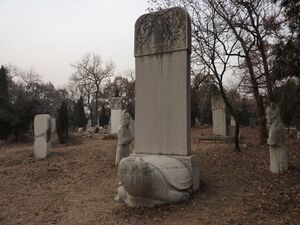
The Shandong Provincial People's Congress is the highest organ of state power in Shandong province and the provincial legislature of Shandong province. Its standing committee performs the majority of power of The Shandong Provincial People's Congress. The current chairman of the standing committee is Liu Jiayi.
The Shandong Provincial People's Government is the State Administration in Shandong province. Its main officials are elected and appointed by The Shandong Provincial People's Congress. The provincial government reports to Shandong Provincial People's Congress and State Council of the People's Republic of China.
The current Governor of Shandong is Gong Zheng.
الاقتصاد
من أهم المحاصيل الزراعية الفول السوداني، البطاطا الحلوة (وتعتبر "شاندونگ" أول منتج في الصين لها)، الحبوب، الصويا، الفواكه، التبغ والقطن. تشتهر المنطقة بتربية دودة الحرير (القز). يتجمع أغلب السكان حول مناطق المنخفض المركزي (في الشمال) وتتكاثف الأراضي المزروعة فيها. على السواحل حيث يسود مناخ معتدل، يتم زراعة الأشجار المثمرة (الكروم، الدراق، الإجاص).
تزخر المقاطعة بالموارد الطبيعية: الذهب، الألمونيوم، الماس، الرخام، الفحم (منجم "تسيبو")، البترول (حقول النفط في "شينگلي" إلى الشمال) والحديد. من أهم الأنشطة الإقتصادية تحويل الحديد والصلب، الكيماويات (السمادات)، والصناعات النسيجية (الحرير).
In 2011, the nominal GDP for Shandong was ¥4.50 trillion (US$711 billion), ranking third in the country (behind Guangdong and Jiangsu). Its GDP per capita was ¥42,014 (US$6,365), ranking eighth. In late 2019 financial reporting noted private company defaults and practices of cross guarantees of debt which troubled investors.[16]
| Historical GDP of Shandong Province for 1952 –present (SNA2008)[17] (purchasing power parity of Chinese Yuan, as Int'l.dollar based on IMF WEO October 2017[18]) | |||||||||
| year | GDP | GDP per capita (GDPpc) based on mid-year population |
Reference index | ||||||
| GDP in millions | real growth (%) |
GDPpc | exchange rate 1 foreign currency to CNY | ||||||
| CNY | USD | PPP (Int'l$.) |
CNY | USD | PPP (Int'l$.) |
USD 1 | Int'l$. 1 (PPP) | ||
| 2016 | 6,802,449 | 1,024,110 | 1,943,057 | 7.6 | 68,733 | 10,348 | 19,633 | 6.6423 | 3.5009 |
| 2015 | 6,393,074 | 1,026,439 | 1,801,120 | 8.0 | 65,114 | 10,454 | 18,345 | 6.2284 | 3.5495 |
| 2014 | 6,030,036 | 981,643 | 1,698,410 | 8.7 | 61,774 | 10,056 | 17,399 | 6.1428 | 3.5504 |
| 2013 | 5,602,372 | 904,601 | 1,566,265 | 9.6 | 57,702 | 9,317 | 16,132 | 6.1932 | 3.5769 |
| 2012 | 5,071,045 | 803,334 | 1,428,142 | 9.9 | 52,490 | 8,315 | 14,783 | 6.3125 | 3.5508 |
| 2011 | 4,543,951 | 703,529 | 1,296,235 | 10.9 | 47,416 | 7,341 | 13,526 | 6.4588 | 3.5055 |
| 2010 | 3,962,074 | 585,283 | 1,196,784 | 12.3 | 41,579 | 6,142 | 12,559 | 6.7695 | 3.3106 |
| 2009 | 3,425,154 | 501,413 | 1,084,768 | 12.2 | 36,270 | 5,310 | 11,487 | 6.8310 | 3.1575 |
| 2008 | 3,123,138 | 449,689 | 983,108 | 12.1 | 33,253 | 4,788 | 10,467 | 6.9451 | 3.1768 |
| 2007 | 2,599,074 | 341,804 | 862,076 | 14.3 | 27,833 | 3,660 | 9,232 | 7.6040 | 3.0149 |
| 2006 | 2,205,967 | 276,721 | 766,573 | 14.7 | 23,775 | 2,982 | 8,262 | 7.9718 | 2.8777 |
| 2005 | 1,849,700 | 225,802 | 646,974 | 15.1 | 20,075 | 2,451 | 7,022 | 8.1917 | 2.8590 |
| 2000 | 833,747 | 100,714 | 306,604 | 10.3 | 9,326 | 1,127 | 3,430 | 8.2784 | 2.7193 |
| 1990 | 151,119 | 31,594 | 88,758 | 5.3 | 1,815 | 379 | 1,066 | 4.7832 | 1.7026 |
| 1980 | 29,213 | 19,496 | 19,534 | 12.2 | 402 | 268 | 269 | 1.4984 | 1.4955 |
| 1978 | 22,545 | 14,498 | 10.1 | 316 | 203 | 1.5550 | |||
| 1970 | 12,631 | 5,131 | 15.7 | 199 | 81 | 2.4618 | |||
| 1965 | 8,625 | 3,504 | 22.0 | 152 | 62 | 2.4618 | |||
| 1957 | 6,139 | 2,358 | -3.5 | 116 | 45 | 2.6040 | |||
| 1952 | 4,381 | 1,971 | 91 | 41 | 2.2227 | ||||
صناعة النبيذ
انتاج النبيذ هو ثاني أكبر[بحاجة لمصدر] صناعة في مقاطعة شاندونگ، فقط بعد الزراعة.
Geographically, the southern hills average an elevation of 200 meters (660 ft), while the coastal areas remain relatively flat. Most of the soil is loose, well-ventilated, and rich in minerals and organic matter that enable full development of the root systems.
Presently, there are more than 140 wineries in the region, mainly distributed in the Nanwang Grape Valley and along the Yan-Peng Sightseeing Highway. The region produced more than 40% of China's grape wine production.[19] Main varieties such as Cabernet Sauvignon, Cabernet Gernischt, Merlot, Riesling and Chardonnay are all at 20 years of age, considered to be the golden stage for these grapes. Most of them maintain an average saccharinity of above 20%.
المنتجون الرئيسيون
. . . . . . . . . . . . . . . . . . . . . . . . . . . . . . . . . . . . . . . . . . . . . . . . . . . . . . . . . . . . . . . . . . . . . . . . . . . . . . . . . . . . . . . . . . . . . . . . . . . . . . . . . . . . . . . . . . . . . . . . . . . . . . . . . . . . . . . . . . . . . . . . . . . . . . . . . . . . . . . . . . . . . . . .
Economic and technological development zones
- Jinan High-tech Industrial Development Zone
Founded in 1991, the Jinan High-tech Industrial Development zone was one of the first of its kind approved by the State Council. The zone is located to the east of the city and covers a total planning area of 83 km2 (32 sq mi) that is divided into a central area covering 33 km2 (13 sq mi), an export processing district of 10 km2 (3.9 sq mi), and an eastern extension area of 40 km2 (15 sq mi). Since its foundation, the Jinan High-tech Industrial Development Zone has attracted enterprises as LG, Panasonic, Volvo, and Sanyo. In 2000, it joined the world science and technology association and set up a China-Ukraine High-tech Cooperation Park. The Qilu Software Park became the sister park of Bangalore park of India.[20]
- Jinan Export Processing Zone
The export processing zone is located in the eastern suburbs of Jinan, to the east of the Jinan High-tech Industrial Development Zone and to the north of the Jiwang highway. The distances to the Jiqing Highway and the Jinan Airport are 9 and 18 km (5.6 and 11.2 mi) respectively.[21]
- Qingdao Economic & Technological Development Area
Approved by the State Council in October 1984, Qingdao Economic and Technical Development Zone has a planned of 12.5 km2 (4.8 sq mi). In 2004 the local GDP is ¥27.51 billion, increased by 28.9%; the total industrial output value is ¥60.6 billion, increased by 31%. There have been 48 projects invested by companies listed among the Global Fortune 500 in the zone. With the fast development of reform and opening-up, Haier, Hisense, Aucma, Sinopec, CSIC, CNOOC, CIMC etc. are all located in the zone.[22]
- Qingdao Free Trade Zone
Qingdao Free Trade Zone was established by the State Council in 1992. The zone is 60 km (37 mi) away from Qingdao Liuting Airport. It is also close to Qingdao Qianwan Container Terminal. At present, more than 40 foreign-invested enterprises have moved in and 2000 projects have been approved. It is one of the special economic areas which enjoys the most favorable investment policies on customs, foreign exchange, foreign trade and taxation in China.[23]
- Qingdao High-tech Industrial Zone
Qingdao High-Tech Industrial Development Zone was approved the State Council in 1992. The zone is located close to Qingdao Liuting Airport and Qingdao Harbor. Encouraged industries include electronic information, biotechnology, medicine, new materials, new energy, advanced equipment manufacturing, marine science & technology, national defense technology.[24]
- Weifang Binhai Economic & Technological Development Area (BEDA)
Established in August 1995, Weifang Binhai Economic & Technological Development Area (BEDA) is a national economic and technological development area approved by the State Council. Covering an area of 677 km2 (261 sq mi), BEDA has a population of 100,000. BEDA possesses a large state-owned industrial land for use with an area of 400 km2 (150 sq mi). The land can be transacted conveniently which would guarantee the demand of any project construction and provide broad development space for the enterprises in the area. Continuously, BEDA has been accredited as National Demonstration Zone invigorating the Sea by Science and Technology, National Innovation Base for Rejuvenating Trade through Science and Technology and National Demonstration Eco-Industry Park.
- Weihai Economic & Technological Development Zone
Weihai Economic and Technological Development Zone is a state-level development zone approved by the State Council on Oct 21, 1992. The administrative area has an area of 194 km2 (75 sq mi), including the programmed area of 36 km2 (14 sq mi) and an initial area of 11.88 km2 (4.59 sq mi). Its nearest port is Weihai Port, and the airport closest to the zone is Wuhai Airport.[25]
- Weihai Export Processing Zone
Weihai Export & Processing Zone (EPZ) was set up by the approval of the State Council on April 27, 2000. Weihai EPZ is located in Weihai Economic & Technological Development Zone with programmed area of 2.6 km2 (1.0 sq mi). Weihai EPZ belongs to comprehensive export & processing zone. The EPZ is located 30 km (19 mi) to Weihai Airport, 3 km (1.9 mi) to Weihai Railway Station and 4 km (2.5 mi) to Weihai Harbor.[26]
- Weihai Torch Hi-Tech Science Park
Weihai Torch Hi-Tech Science Park is a state-level development zone approved by the State Council in March 1991. Located in Weihai's northwest zone of culture, education and science, the Park has the total area of 111.9 square kilometers (43.2 sq mi), the coastal line of 30.5 kilometers (19.0 mi) and 150,000 residents. It is 3 km (1.9 mi) away from the city center, 4 km (2.5 mi) away from Weihai Port, 10 km (6.2 mi) away from Weihai Railway Station, 30 km (19 mi) away from Weihai Airport and 80 km (50 mi) away from Yantai Airport.[27]
- Yantai Economic and Technological Development Area
Yantai Economic and Technological Development Area is one of the earliest approved state level economic development zones in China. It now has planned area of 10 km2 (3.9 sq mi) and a population of 115,000. It lies on the tip of the Shandong Peninsula facing the Huanghai Sea. It adjoins to downtown Yantai, merely 6 km (3.7 mi) away from Yantai Port, 6 km (3.7 mi) away from Yantai Railway Station, and a 30-minute drive to Yantai International Airport.[28]
- Yantai Export Processing Zone
Yantai Export Processing Zone (YTEPZ) is one of the first 15 export processing zones approved by the State Council. The total construction area of YTEPZ is 4.17 m2 (44.9 sq ft), in which the initial zone covers 3 km2 (1.2 sq mi). After developing for several years, YTEPZ is completely constructed. At present, the infrastructure has been completed, standard workshops of 120,000 m2 (140,000 sq yd) and bonded warehouses of 40,000 m2 (430,000 sq ft) have been built up. Up to now, owning perfect investment environment and conditions, YTEPZ has attracted investors both from foreign countries and regions such as Japan, Korea, Singapore, Hong Kong, Taiwan, Sweden, the United States, Canada, etc. and from the domestic to invest and operate in the zone.[29]
- Zibo National New & Hi-Tech Industrial Development Zone
الديموغرافيا
| التعداد على مر التاريخ | ||
|---|---|---|
| السنة | تعداد | ±% |
| 1912[30] | 30٬989٬000 | — |
| 1928[31] | 28٬672٬000 | −7.5% |
| 1936-37[32] | 38٬100٬000 | +32.9% |
| 1947[33] | 38٬865٬000 | +2.0% |
| 1954[34] | 48٬876٬548 | +25.8% |
| 1964[35] | 55٬519٬038 | +13.6% |
| 1982[36] | 74٬419٬054 | +34.0% |
| 1990[37] | 84٬392٬827 | +13.4% |
| 2000[38] | 89٬971٬789 | +6.6% |
| 2010[39] | 95٬793٬065 | +6.5% |
| Qingdao was part of Shandong Province until 1929; dissolved in 1949 and incorporated into Shandong Province. Weihai also known as Weihaiwei. Established in 1930; dissolved in 1945 and incorporated into Shandong Province. | ||
Shandong is the second most populous province of China, after Guangdong, just slightly ahead of Henan, with a population of more than 95,793,000 at the 2010 Census. Over 99% of Shandong's population is Han Chinese. Minority groups include the Hui and the Manchus. Shandong citizens are also known to have the tallest average height of any Chinese province. As of 2010, 16-18-year-old male students in Yantai measured 176.4 centimetres (5 ft 9.4 in) while female students measured 164 cm (5 ft 5 in).[40]
التقسيمات الإدارية
تنقسسم شان دونگ إلى 17 تقسيم على مستوى محافظة، وجميعهم مدن على مستوى محافظات.
On January 1, 2019, Laiwu was wholly annexed to Jinan:
| التقسيمات الادارية لشاندونگ | |||||||||||
|---|---|---|---|---|---|---|---|---|---|---|---|
| Division code[41] | Division | Area in km2[42] | Population 2010[43] | Seat | Divisions[44] | ||||||
| Districts | النواحي | مدن نواحي | |||||||||
| 370000 | مقاطعة شاندونگ | 157100.00 | 95,792,719 | مدينة جينان | 58 | 52 | 26 | ||||
| 370100 | مدينة جينان | 10247.01 | 8,112,513 | Lixia District | 10 | 2 | |||||
| 370200 | مدينة چینگداو | 11175.30 | 8,715,087 | Shinan District | 7 | 3 | |||||
| 370300 | Zibo city | 5965.17 | 4,530,597 | Zhangdian District | 5 | 3 | |||||
| 370400 | Zaozhuang city | 4563.22 | 3,729,140 | Xuecheng District | 5 | 1 | |||||
| 370500 | Dongying city | 7923.26 | 2,035,338 | Dongying District | 3 | 2 | |||||
| 370600 | مدينة يانتاي | 13746.47 | 6,968,202 | Laishan District | 5 | 6 | |||||
| 370700 | مدينة وِيْفانگ | 16143.14 | 9,086,241 | Kuiwen District | 4 | 2 | 6 | ||||
| 370800 | Jining city | 11186.98 | 8,081,905 | Rencheng District | 2 | 7 | 2 | ||||
| 370900 | مدينة تايآن | 7761.83 | 5,494,207 | Taishan District | 2 | 2 | 2 | ||||
| 371000 | مدينة وِيْهاي | 5796.98 | 2,804,771 | Huancui District | 2 | 2 | |||||
| 371100 | مدينة ريژاو | 5347.99 | 2,801,013 | Donggang District | 2 | 2 | |||||
| 371300 | Linyi city | 17191.21 | 10,039,440 | Lanshan District | 3 | 9 | |||||
| 371400 | Dezhou city | 10356.32 | 5,568,235 | Decheng District | 2 | 7 | 2 | ||||
| 371500 | مدينة لياوتشنگ | 8714.57 | 5,789,863 | Dongchangfu District | 2 | 5 | 1 | ||||
| 371600 | مدينة Binzhou | 9444.65 | 3,748,474 | Bincheng District | 2 | 4 | 1 | ||||
| 371700 | Heze city | 12193.85 | 8,287,693 | Mudan District | 2 | 7 | |||||
| التقسيمات الادارية بالصينية وبتنويعات الرومنة | ||||
|---|---|---|---|---|
| بالعربية | بالصينية | پنين | ||
| مقاطعة شاندونگ | 山东省 | Shāndōng Shěng | ||
| مدينة جينان | 济南市 | Jǐnán Shì | ||
| مدينة چینگداو | 青岛市 | Qīngdǎo Shì | ||
| Zibo city | 淄博市 | Zībó Shì | ||
| Zaozhuang city | 枣庄市 | Zǎozhuāng Shì | ||
| Dongying city | 东营市 | Dōngyíng Shì | ||
| مدينة يانتاي | 烟台市 | Yāntái Shì | ||
| مدينة وِيْفانگ | 潍坊市 | Wéifāng Shì | ||
| Jining city | 济宁市 | Jǐníng Shì | ||
| مدينة تايآن | 泰安市 | Tài'ān Shì | ||
| مدينة وِيْهاي | 威海市 | Wēihǎi Shì | ||
| Rizhao city | 日照市 | Rìzhào Shì | ||
| Linyi city | 临沂市 | Línyí Shì | ||
| Dezhou city | 德州市 | Dézhōu Shì | ||
| Liaocheng city | 聊城市 | Liáochéng Shì | ||
| Binzhou city | 滨州市 | Bīnzhōu Shì | ||
| Heze city | 菏泽市 | Hézé Shì | ||
The 16 prefecture-level cities of Shandong are subdivided into 137 county-level divisions (55 districts, 26 county-level cities, and 56 counties). Those are in turn divided into 1941 township-level divisions (1223 towns, 293 townships, two ethnic townships, and 423 subdistricts).
المناطق الحضرية
| التعداد حسب المناطق الحضرية للمدن المحافظات والمدن النواحي | |||||
|---|---|---|---|---|---|
| # | المدينة | المساحة الحضرية[45] | مساحة المديرية[45] | المدينة نفسها[45] | تاريخ التعداد |
| 1 | جينان[أ] | 3,527,566 | 4,335,989 | 8,396,142 | 2010-11-01 |
| (1) | Jinan (new districts)[أ] | 1,261,040 | 2,880,687 | see Jinan | 2010-11-01 |
| 2 | Qingdao[ب] | 3,519,919 | 3,718,835 | 8,715,087 | 2010-11-01 |
| (2) | Qingdao (new district)[ب] | 1,036,158 | 2,045,549 | see Qingdao | 2010-11-01 |
| 3 | Zibo | 2,261,717 | 3,129,228 | 4,530,597 | 2010-11-01 |
| 4 | Yantai | 1,797,861 | 2,227,733 | 6,968,202 | 2010-11-01 |
| 5 | Linyi | 1,522,488 | 2,303,648 | 10,039,440 | 2010-11-01 |
| 6 | Weifang | 1,261,582 | 2,044,028 | 9,086,241 | 2010-11-01 |
| 7 | Tai'an | 1,123,541 | 1,735,425 | 5,494,207 | 2010-11-01 |
| 8 | Zaozhuang | 980,893 | 2,125,481 | 3,729,140 | 2010-11-01 |
| 9 | Jining[ت] | 939,034 | 1,241,012 | 8,081,905 | 2010-11-01 |
| (9) | Jining (new district)[ت] | 388,449 | 618,394 | see Jining | 2010-11-01 |
| 10 | Rizhao | 902,272 | 1,320,578 | 2,801,013 | 2010-11-01 |
| 11 | Dongying[ث] | 848,958 | 1,004,271 | 2,035,338 | 2010-11-01 |
| (11) | Dongying (new district)[ث] | 114,073 | 242,292 | see Dongying | 2010-11-01 |
| 12 | Tengzhou | 783,473 | 1,603,659 | see Zaozhuang | 2010-11-01 |
| 13 | Weihai[ج] | 698,863 | 844,310 | 2,804,771 | 2010-11-01 |
| (13) | Weihai (new district)[ج] | 310,628 | 673,625 | see Weihai | 2010-11-01 |
| 14 | Xintai | 672,207 | 1,315,942 | see Tai'an | 2010-11-01 |
| 15 | Liaocheng | 606,366 | 1,229,768 | 5,789,863 | 2010-11-01 |
| 16 | Zhucheng | 586,652 | 1,086,222 | see Weifang | 2010-11-01 |
| 17 | Heze[ح] | 559,636 | 1,346,717 | 8,287,693 | 2010-11-01 |
| (17) | Heze (new district)[ح] | 166,037 | 565,793 | see Heze | 2010-11-01 |
| 18 | Dezhou[خ] | 526,232 | 679,535 | 5,568,235 | 2010-11-01 |
| (18) | Dezhou (new district)[خ] | 170,317 | 569,007 | see Dezhou | 2010-11-01 |
| 19 | Zoucheng | 513,418 | 1,116,692 | see Jining | 2010-11-01 |
| 20 | Shouguang | 476,274 | 1,139,454 | see Weifang | 2010-11-01 |
| 21 | Feicheng | 472,775 | 946,627 | see Tai'an | 2010-11-01 |
| 22 | Gaomi | 466,786 | 895,582 | see Weifang | 2010-11-01 |
| 23 | Pingdu | 427,694 | 868,348 | see Qingdao | 2010-11-01 |
| 24 | Binzhou[د] | 407,820 | 682,717 | 3,748,474 | 2010-11-01 |
| (24) | Binzhou (new district)[د] | 146,577 | 351,672 | see Binzhou | 2010-11-01 |
| 25 | Jiaozhou | 404,216 | 1357,424 | see Qingdao | 2010-11-01 |
| (26) | Zouping[ذ] | 389,003 | 778,777 | see Binzhou | 2010-11-01 |
| 27 | Longkou | 388,770 | 688,255 | see Yantai | 2010-11-01 |
| 28 | Qingzhou | 384,358 | 940,355 | see Weifang | 2010-11-01 |
| 29 | Laizhou | 379,789 | 883,896 | see Yantai | 2010-11-01 |
| 30 | Linqing | 376,337 | 719,611 | see Liaocheng | 2010-11-01 |
| 31 | Rongcheng | 363,420 | 714,355 | see Weihai | 2010-11-01 |
| 32 | Laiyang | 358,092 | 878,591 | see Yantai | 2010-11-01 |
| 33 | Laixi | 347,452 | 750,225 | see Qingdao | 2010-11-01 |
| 34 | Qufu | 302,805 | 640,498 | see Jining | 2010-11-01 |
| 35 | Anqiu | 300,160 | 926,894 | see Weifang | 2010-11-01 |
| 36 | Changyi | 287,720 | 603,482 | see Weifang | 2010-11-01 |
| 37 | Zhaoyuan | 281,780 | 566,244 | see Yantai | 2010-11-01 |
| 38 | Rushan | 259,876 | 572,481 | see Weihai | 2010-11-01 |
| 39 | Haiyang | 244,600 | 638,729 | see Yantai | 2010-11-01 |
| 40 | Leling | 214,238 | 652,415 | see Dezhou | 2010-11-01 |
| 41 | Qixia | 204,633 | 589,620 | see Yantai | 2010-11-01 |
| 42 | Yucheng | 203,724 | 490,031 | see Dezhou | 2010-11-01 |
| 43 | Penglai | 185,894 | 451,109 | see Yantai | 2010-11-01 |
- ^ أ ب Laiwu PLC is currently no longer exist after census it merged with Jinan in 2019. Laiwu PLC's districts merged after census: Laiwu (Laicheng), Gangcheng; and new districts established after census: Zhangqiu (Zhangqiu CLC), Jiyang (Jiyang County). Laiwu PLC's districts and the new districts not included in the urban area & district area count of the pre-expanded city.
- ^ أ ب New district established after census: Jimo (Jimo CLC); Jiaonan CLC merged into Xihai'an (Huangdao) after census. The new district and annexed area not included in the urban area & district area count of the pre-expanded city.
- ^ أ ب New district established after census: Yanzhou (Yanzhou CLC). The new district not included in the urban area & district area count of the pre-expanded city.
- ^ أ ب New district established after census: Kenli (Kenli County). The new district not included in the urban area & district area count of the pre-expanded city.
- ^ أ ب New district established after census: Wendeng (Wendeng CLC). The new district not included in the urban area & district area count of the pre-expanded city.
- ^ أ ب New district established after census: Dingtao (Dingtao County). The new district not included in the urban area & district area count of the pre-expanded city.
- ^ أ ب New district established after census: Lingcheng (Lingxian County). The new district not included in the urban area & district area count of the pre-expanded city.
- ^ أ ب New district established after census: Zhanhua (Zhanhua County). The new district not included in the urban area & district area count of the pre-expanded city.
- ^ Zouping County is currently known as Zouping CLC after census.
الثقافة
Mandarin dialects are spoken in Shandong. Linguists classify these dialects into three broad categories: Ji Lu Mandarin spoken in the northwest (as well as in neighbouring Hebei), such as the Jinan dialect; Zhongyuan Mandarin spoken in the southwest (as well as in neighbouring Henan); and Jiao Liao Mandarin spoken in the Shandong Peninsula (as well as the Liaodong Peninsula across the sea), such as the Qingdao dialect. When people speak of the "Shandong dialect" (山東話�), it is generally the first or the second that is meant; the Jiao Liao dialects of Shandong are commonly called the "Jiaodong dialect" (膠東話�).
Shandong cuisine (鲁菜�) is one of the eight great traditions of Chinese cuisine. It can be more finely divided into inland Shandong cuisine (e.g. Jinan cuisine); the seafood-centered Jiaodong cuisine in the peninsula; and Confucius's Mansion cuisine, an elaborate tradition originally intended for imperial and other important feasts.
Shandong Bangzi and Lüju are popular types of Chinese opera in Shandong; both originated from southwestern Shandong.
الدين
The predominant religions in Shandong are Chinese folk religions, Taoist traditions and Chinese Buddhism. According to surveys conducted in 2007 and 2009, 25,28% of the population believes and is involved in ancestor veneration, while 1.21% of the population identifies as Christian, decreasing from 1.30% in 2004.[46] The Christians were 1.89% of the province's population in 1949, the largest proportion in China at that time.[46] According to a survey of the year 2010, Muslims constitute 0.55% of the population of Shandong up from 0.14% in 1949.[47]
The reports didn't give figures for other types of religion; 80.05% of the population may be either irreligious or involved in worship of nature deities, Buddhism, Confucianism, Taoism and folk religious sects. Shandong is the province where Confucius was born in the year 551 B.C.
Confucianism: The most well known humanity of Shandong is Confucianism. Each year thousands of people come to Shandong to visit and learn about Confucius' culture. Confucius, according to Chinese tradition, was a thinker, political figure, educator, and founder of the Ru School of Chinese thought. His teachings, preserved in the Lunyu or Analects, form the foundation of much of subsequent Chinese speculation on the education and comportment of the ideal man, how such an individual should live his life and interact with others, and the forms of society and government in which he should participate. Additionally, there are many famous books about Confucius; the most famous one is the Analects which was written by his students. Confucius also helped edit The Five Classics (五经). The Five Classics include The Book of Songs, History, Changes and Rites.[48][49]
Famous view and arts
- Northern Shaolin Seven Star Praying Mantis Style of Kung fu is also taught in this province. It is also said that Northern Mantis had originated here and not in the Shaolin temple in Henan Province, which is always stated in books.
- Guandi is also known for Guangong, Guanyu. He is a famous general in the book Romance of the Three Kingdoms. In Daojiao (a traditional Chinese Religion) Guangong is also one of the four Protectors.[بحاجة لمصدر]
- Temple and Cemetery of Confucius and the Kong is a very famous World Heritage Site in China and it is also a 5A Tourist Attraction. Lying to the east of the Temple, the Kong Family Mansion developed from a small family house linked to the temple into an aristocratic mansion in which the male direct descendants of Confucius lived and worked.[50][51]
|
النقل
السياحة
التعليم
الجامعات والكليات
- Shandong University (Jinan)
- Ocean University of China (Qingdao)
- China University of Petroleum (Dongying and Qingdao)
- University of Jinan (Jinan)
- Shandong Normal University
- Shandong Agricultural University (Tai'an)
- Shandong University of Finance and Economics (Jinan)
- Shandong University of Traditional Chinese Medicine (Jinan)
- Harbin Institute of Technology (Weihai)
- China Agricultural University (Yantai)
- Harbin University of Science and Technology (Weihai)
- Yantai University (Yantai)
- Qufu Normal University (Qufu)
- Qingdao University (Qingdao)
- Shandong University of Science and Technology (Qingdao)
- Shandong University of Technology (Zibo)
- Liaocheng University (Liaocheng)
- Linyi University (Linyi)
- Qingdao Agricultural University (Qingdao)
- Binzhou Medical College (Binzhou)
- Jining Medical University (Jining)
- Weifang Medical University (Weifang)
- Weifang University (Weifang)
- Shandong Institute of Business and Technology (Yantai)
- Shandong Women's University (Jinan)
- Qingdao Technical College (Qingdao)
- Rizhao Polytechnic (Rizhao)
- Zibo Vocational Institute (Zibo)
- Qingdao Binhai University (Qingdao)
- Shandong Foreign Languages Vocational College (Rizhao)
الرياضة
انظر أيضا
- Major national historical and cultural sites in Shandong
- Shandong people
- Shantungosaurus
- Shantung Problem
- East Asian snowstorms of 2009–2010
- East Asian snowstorms of late 2009
Notes
- ^ The data was collected by the Chinese General Social Survey (CGSS) of 2009 and by the Chinese Spiritual Life Survey (CSLS) of 2007, reported and assembled by Xiuhua Wang (2015)[46] in order to confront the proportion of people identifying with two similar social structures: ① Christian churches, and ② the traditional Chinese religion of the lineage (i. e. people believing and worshipping ancestral deities often organised into lineage "churches" and ancestral shrines). Data for other religions with a significant presence in China (deity cults, Buddhism, Taoism, folk religious sects, Islam, et. al.) was not reported by Wang. The number of Muslims is taken from a survey reported in the year 2010.[47]
- ^ This may include:
- Buddhists
- Confucians
- Deity worshippers
- Taoists
- Members of folk religious sects
- People not bounded to, nor practicing any, institutional or diffuse religion
الهوامش
- ^ "Doing Business in China - Survey". Ministry Of Commerce - People's Republic Of China. Retrieved 5 August 2013.
- ^ أ ب "National Data of the National Bureau of Statistics of China on Major Figures of the 2016 Population Census [1] (No. 2)".
- ^ 山东省2017年国民经济和社会发展统计公报 [Statistical Communiqué of Shandong on the 2017 National Economic and Social Development] (in الصينية). Shandong Bureau of Statistics. 2018-02-27. Retrieved 2018-06-22.
- ^ "Sub-national HDI – Area Database – Global Data Lab". hdi.globaldatalab.org (in الإنجليزية). Retrieved 13 September 2018.
- ^ Centre, UNESCO World Heritage. "Mount Taishan". UNESCO World Heritage Centre (in الإنجليزية). Retrieved 2019-09-30.
- ^ Kelly, Margaret (2007). China (in الإنجليزية). Fodor's Travel Publications. p. 157. ISBN 9781400017317.
- ^ "Confucianism". Asia Society (in الإنجليزية). Retrieved 2020-11-04.
- ^ "China's wealth gap widens as more provinces missed 2018 growth targets". South China Morning Post (in الإنجليزية). 2019-02-12. Retrieved 2019-06-05.
- ^ (in صينية) Origin of the Names of China's Provinces, People's Daily Online.
- ^ Roberts, Edmund (1837). Embassy to the Eastern Courts of Cochin-China, Siam, and Muscat. New York: Harper & Brothers. pp. 122–123.
- ^ Thomas W. Burkman, Japan and the League of Nations: Empire and world order, 1914–1938 (U of Hawaii Press, 2007_. p 4.
- ^ Stephen G. Craft, "John Bassett Moore, Robert Lansing, and the Shandong Question." Pacific Historical Review 66.2 (1997): 231-249. online
- ^ "CHINA: Basest War Lord"
- ^ Chang-Sheng, Gu (August 2009). Awaken: Memoirs of a Chinese Historian. ISBN 9781449006181.
- ^ "China finds major dinosaur site". December 31, 2008 – via news.bbc.co.uk.
- ^ Bloomberg News with Wilkins, Rebecca Choong, Zhu, Lin, et al (16 December 2019). "Defaults in One of China’s Richest Provinces Spook Investors." Bloomberg News website Retrieved 19 December 2019.
- ^ China NBS / Bulletin on Reforming Shandong's GDP Accounting and Data: sd.gov.cn (13-Oct-17) (Chinese)
- ^ Purchasing power parity (PPP) for Chinese yuan is estimate according to IMF WEO (October 2017) data; Exchange rate of CN¥ to US$ is according to State Administration of Foreign Exchange, published on China Statistical Yearbook.
- ^ "Archived copy". Archived from the original on 2009-02-15. Retrieved 2009-06-28.
{{cite web}}: CS1 maint: archived copy as title (link) - ^ RightSite.asia | Jinan High-tech Industrial Development Zone
- ^ RightSite.asia | Jinan Export Processing Zone
- ^ RightSite.asia | Qingdao Economic & Technological Development Area
- ^ RightSite.asia | Qingdao Free Trade Zone
- ^ RightSite.asia | Qingdao High-tech Industrial Zone
- ^ RightSite.asia | Weihai Economic & Technological Development Zone
- ^ RightSite.asia | Weihai Export Processing Zone
- ^ RightSite.asia | Weihai Torch Hi-Tech Science Park
- ^ RightSite.asia | Yantai Economic and Technological Development Area
- ^ RightSite.asia | Yantai Export Processing Zone
- ^ 1912年中国人口. Retrieved 6 March 2014.
- ^ 1928年中国人口. Retrieved 6 March 2014.
- ^ 1936-37年中国人口. Retrieved 6 March 2014.
- ^ 1947年全国人口. Retrieved 6 March 2014.
- ^ 中华人民共和国国家统计局关于第一次全国人口调查登记结果的公报. National Bureau of Statistics of China. Archived from the original on 2009-08-05.
- ^ 第二次全国人口普查结果的几项主要统计数字. National Bureau of Statistics of China. Archived from the original on 2012-09-14.
- ^ 中华人民共和国国家统计局关于一九八二年人口普查主要数字的公报. National Bureau of Statistics of China. Archived from the original on 2012-05-10.
- ^ 中华人民共和国国家统计局关于一九九〇年人口普查主要数据的公报. National Bureau of Statistics of China. Archived from the original on 2012-06-19.
- ^ 现将2000年第五次全国人口普查快速汇总的人口地区分布数据公布如下. National Bureau of Statistics of China. Archived from the original on 2012-08-29.
- ^ "Communiqué of the National Bureau of Statistics of People's Republic of China on Major Figures of the 2010 Population Census". National Bureau of Statistics of China. Archived from the original on 2013-07-27.
- ^ "Average height in Yantai". 2015. Retrieved 2018-04-29.
- ^ 中华人民共和国县以上行政区划代码 (in الصينية المبسطة). Ministry of Civil Affairs.
- ^ Shenzhen Bureau of Statistics. 《深圳统计年鉴2014》 (in الصينية المبسطة). China Statistics Print. Retrieved 2015-05-29.
- ^ Census Office of the State Council of the People's Republic of China; Population and Employment Statistics Division of the National Bureau of Statistics of the People's Republic of China (2012). 中国2010人口普查分乡、镇、街道资料 (1 ed.). Beijing: China Statistics Print. ISBN 978-7-5037-6660-2.
- ^ Ministry of Civil Affairs (August 2014). 《中国民政统计年鉴2014》 (in الصينية المبسطة). China Statistics Print. ISBN 978-7-5037-7130-9.
- ^ أ ب ت 国务院人口普查办公室、国家统计局人口和社会科技统计司编 (2012). 中国2010年人口普查分县资料. Beijing: China Statistics Print. ISBN 978-7-5037-6659-6.
- ^ أ ب ت ث China General Social Survey 2009, Chinese Spiritual Life Survey (CSLS) 2007. Report by: Xiuhua Wang (2015, p. 15)
- ^ أ ب Min Junqing. The Present Situation and Characteristics of Contemporary Islam in China. JISMOR, 8. 2010 Islam by province, page 29. Data from: Yang Zongde, Study on Current Muslim Population in China, Jinan Muslim, 2, 2010.
- ^ "Confucius". Stanford Encyclopedia of Philosophy. Retrieved 7 December 2016.
- ^ "Confucius (551—479 B.C.E.)". IEP. Retrieved 7 December 2016.
- ^ "Temple and Cemetery of Confucius and the Kong Family Mansion in Qufu". UNESCO. Retrieved 7 December 2016.
- ^ "The Confucian Temple, Cemetery and Family Mansion in Qufu". China.org. Retrieved 7 December 2016.
وصلات خارجية
- موقع حكومة شان دونگ
- (in صينية) Shandong Government website
- (in إنگليزية and صينية) Complete Map of the Seven Coastal Provinces from 1821-1850
- Shandong Article Encyclopædia Britannica
- CS1 uses الصينية-language script (zh)
- CS1 الصينية-language sources (zh)
- Articles with صينية-language sources (zh)
- CS1 uses اليابانية-language script (ja)
- CS1 الصينية المبسطة-language sources (zh-hans)
- Short description is different from Wikidata
- Missing redirects
- Articles containing صينية-language text
- Pages using multiple image with auto scaled images
- Coordinates on Wikidata
- Pages using infobox settlement with missing country
- مقالات تحتوي نصوصاً باللغة الصينية المبسطة
- مقالات تحتوي نصوصاً باللغة الصينية التقليدية
- Articles with unsourced statements from April 2016
- Articles with hatnote templates targeting a nonexistent page
- Articles with unsourced statements from September 2011
- مقالات تحتوي نصوصاً باللغة الصينية
- Articles with unsourced statements from March 2020
- Articles with إنگليزية-language sources (en)
- شاندونگ
- مقاطعات الصين
- شرق الصين



